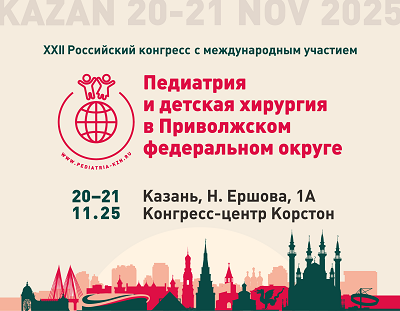Orbital complications of rhinosinusitis in pediatric practice
https://doi.org/10.21508/1027-4065-2025-70-5-50-55
Abstract
Background. Complications of acute rhinosinusitis remain a serious problem in pediatrics due to the high risk of adverse outcome. Despite the era of modern diagnostic methods, antibiotics, vaccines, the number of orbital complications of acute rhinosinusitis is not approaching zero.
Aim: to analyze the medical records of patients with orbital rhinosinusogenic complications and to identify factors contributing to the development of complications.
Materials and methods. A total of 37 medical records of patients aged 0 to 15 years with orbital complications of acute rhinosinusitis in 2023–2024, who received examination and treatment at the Kazan Children’s Republican Clinical Hospital, were retrospectively analyzed. The data were analyzed using the StatTech v. 4.2.6 program (developer — Stattech LLC, Russia).
Results and discussion. Treated in 2023. — 27 patients, in 2024 — 10 patients, 30% received antibacterial therapy at the prehospital stage. The median age of patients in the study was 6.97±4.04 years, patients aged 8 to 14 years prevailed (n=16). 27 boys (73%), 10 girls (27%) (p=0.012). Orbital complications are represented by subperiosteal orbital abscess (n=20, 54%) and preseptal cellulitis with reactive edema and eyelid hyperemia (46%, n=17). 67.6% of patients (n=25) were not vaccinated against S. Pneumoniae, 12 patients had at least one S. Pneumoniae vaccine (p=0.033). 9 patients (24.3%) were immunized against H. Influenzae, of which only 7 patients were immunized according to the full regimen.
Conclusions. The high-risk group includes children aged 0 to 7 years, especially boys. A decrease in the collective immunity of the pediatric population due to various reasons contributes to a more frequent incidence of acute rhinosinusitis. Endoscopic rhinosinussurgery minimizes surgical trauma and reduces the length of hospital stay. 70% of patients in the study did not receive antibiotics at the prehospital stage, adequate dosages of which should be considered an additional controllable factor preventing complications of acute rhinosinusitis.
About the Authors
I. G. AndreevaRussian Federation
420138, Kazan
A. R. Khanafieva
Russian Federation
420012, Kazan
R. N. Mamleev
Russian Federation
420012, Kazan
References
1. Bogomil’skii M.R., Chistyakova V.R. Pediatric Otorhinolaryngology: A Guide for students, physicians. 2nd edition, M.: GEOTAR-Media, 2012; 576. (in Russ)
2. Andreeva I.V., Stetsyuk O.U., Egorova O.A. Respiratory tract infections in pediatrics: difficult answers to simple questions. RMZh. Mat’ i ditja. 2020; 3(2): 105–111. (in Russ) DOI: 10.32364/2618-8430-2020-3-2-105-111
3. Benninger M.S., Manz R. The impact of vaccination on rhinosinusitis and otitis media. Curr Allergy Asthma Rep. 2010; 10: 411–418. DOI: 10.1007/s11882-010-0139-6
4. Ambati B.K., Ambati J., Azar N., Stratton L., Schmidt E.V. Periorbital and orbital cellulitis before and after the advent of Haemophilus influenza type B vaccine. Ophthalmology. 2000; 107: 1450–1453. DOI: 10.1016/s0161-6420(00)00178-0
5. Brook I., Gober A.E. Frequency of recovery of pathogens from the nasopharynx of children with acute maxillary sinusitis before and after the introduction of vaccination with the 7-valent pneumococcal vaccine. Int J Pediatr Otorhinolaryngol. 2007; 71: 575–579. DOI: 10.1016/j.ijporl.2006.10.025
6. Nocon C.C., Baroody F.M. Acute rhinosinusitis in children. Curr Allergy Asthma Rep. 2014; 14(6): 443. DOI: 10.1007/s11882-014-0443-7
7. Zhao E.E., Koochakzadeh S., Nguyen S.A., Yoo F., Pecha P., Schlosser R.J. Orbital complications of acute bacterial rhinosinusitis in the pediatric population: A systematic review and meta-analysis. Int J Pediatr Otorhinolaryngol. 2020; 135: 110078. DOI: 10.1016/j.ijporl.2020.110078
8. Friedrich L., Sadeh R., Hazan I., Kordeluk S., Sabri E.S., Tsumi E., et al. Orbital complications of pediatric acute rhinosinusitis in the pneumococcal conjugate vaccine era. Pediatr Neonatol. 2025; 66(2): 116–121. DOI: 10.1016/j.ped-neo.2023.12.009
9. Wong S.J., Levi J. Management of pediatric orbital cellulitis: A systematic review. Int J Pediatr Otorhinolaryngol. 2018; 110: 123−129. DOI: 10.1016/j.ijporl.2018.05.006
10. Torretta S., Guastella C., Marchisio P., Marom T., Bosis S., Ibba T. et al. Sinonasal-related orbital infections in children: a clinical and therapeutic overview. J Clin Med. 2019; 8(1): 101. DOI: 10.3390/jcm8010101
11. Veshkurtseva I.M., Kuznetsova N.E., Izvin A.I., Ponomareva M.N., Izmailova A.А., Yudina S.S. Orbital complications of rhinogenic etiology in children: some aspects. Ural’skij medicinskij zhurnal 2023; 22(3): 37−45. (in Russ) DOI: 10.52420/2071-5943-2023-22-3-37-45
12. Krasnozhen V.N., Andreeva I.G., Luchkina E.V., Mamleev R.N., Slavina A.L. Hemisinusitis complicated by cellulitis of orbit and of abscess of the infratemporal fossa at the 8-year-old child. Folia Otorhinolaryngologiae et Pathologiae Respiratoriae. 2020; 26 (3): 101–106 (in Russ) DOI: 10.33848/foliorl23103825-2020-26-3-101-106
13. Wyler B., Mallon W.K. Sinusitis Update. Emerg Med Clin North Am. 2019; 37(1): 41–54. DOI: 10.1016/j.emc.2018.09.007
14. Levy D.A., Nguyen S.A., Harvey R., Hopkins C., Schlosser R.J. Hospital utilization for orbital and intracranial complications of pediatric acute rhinosinusitis. International Journal of Pediatric Otorhinolaryngology. 2020; 128: 109696. DOI: 10.1016/j.ijporl.2019.109696
15. Lai K., Satia I., Song W.J., Wang G., Niimi A., Pattemore P., et al. Cough and cough hypersensitivity as treatable traits of asthma. Lancet Respir Med. 2023; 11(7): 650–662. DOI: 10.1016/S2213-2600(23)00187-X
16. Schwartz T.R., Adams M.D., Wertz A. Systemic corticosteroids for orbital complications of pediatric rhinosinusitis: A systematic review. Int J Pediatr Otorhinolaryngol. 2023; 167: 111336. DOI: 10.1016/j.ijporl.2022.111336
17. Boiko N.V., Stagnieva I.V., Gukasyan E.L., Stateshnaya P.A. Children’s rhinosinusitis orbital complications. Vestnik otorinolaringologii 2022; 88(2): 74–79. (in Russ). DOI: 10.17116/otorino20228802174
18. Guide to Rhinology. Editors G.Z. Piskunova, S.Z. Piskunova. M.: Litterra, 2011; 960 pp. (in Russ)
19. Klimenko K.E., Rusetsky Yu.Yu., Kudryashov S.E., Kryukov A.I., Tovmasyan A.S. Long-term results of extended endoscopic interventions in severe forms of chronic frontal sinusitis. Rossijskaya rinologiya 2022; 30(2): 72–78. (in Russ). DOI: 10.17116/rosrino20223002172
20. Gaidukov S.S., Voronov A.V., Golubev A. Yu., Sapova K.I., Naumenko A.N. Case report of lothrop procedure in patient with recurrent frontal sinus mucocele. Rossiiskaya otorinolaringologiya 2022; 21(4): 98-102. (in Russ) DOI: 10.18692/1810-4800-2022-4-98-102
21. The Federal Service for Supervision of Consumer Rights Protection and Human Well-being. Laboratory diagnostics of community-acquired pneumonia of pneumococcal etiology: Methodological recommendations. M., 2017: 6–8. (in Russ). https://files.stroyinf.ru/Data2/1/4293743/4293743035.pdf Ссылка активна на 14.06.2025
Review
For citations:
Andreeva I.G., Khanafieva A.R., Mamleev R.N. Orbital complications of rhinosinusitis in pediatric practice. Rossiyskiy Vestnik Perinatologii i Pediatrii (Russian Bulletin of Perinatology and Pediatrics). 2025;70(5):50-55. (In Russ.) https://doi.org/10.21508/1027-4065-2025-70-5-50-55










































